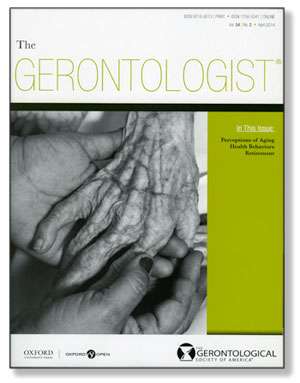 I really like my latest cover on The Gerontologist as it expresses the essence of frailty in old age and the process of caring. I took this picture on a trip to San Antonio in 2012, at a nursing home called Buena Vida Nursing & Rehabilitation Center. This facility is located in a largely Hispanic neighborhood, and its institutional culture is geared toward caring for the community’s elders. An organization’s culture is increasingly recognized as important cornerstone for providing high-quality long-term care.
I really like my latest cover on The Gerontologist as it expresses the essence of frailty in old age and the process of caring. I took this picture on a trip to San Antonio in 2012, at a nursing home called Buena Vida Nursing & Rehabilitation Center. This facility is located in a largely Hispanic neighborhood, and its institutional culture is geared toward caring for the community’s elders. An organization’s culture is increasingly recognized as important cornerstone for providing high-quality long-term care.
 Organizational culture refers to the attitudes, experiences, and values both personal and cultural of an organization. Important elements for implementing a positive, patient centered culture include teamwork, communication and leadership. Most nursing homes in America focus on illness and dependency, with rigorously organized schedules and a focus on regulatory compliance. The lives of residents often lack choice, meaning, and purpose and there is little sense of being “at home.” Institutions that have embraced culture change incorporate community-based services and foster personal choices in meaningful ways in a homelike environment.
Organizational culture refers to the attitudes, experiences, and values both personal and cultural of an organization. Important elements for implementing a positive, patient centered culture include teamwork, communication and leadership. Most nursing homes in America focus on illness and dependency, with rigorously organized schedules and a focus on regulatory compliance. The lives of residents often lack choice, meaning, and purpose and there is little sense of being “at home.” Institutions that have embraced culture change incorporate community-based services and foster personal choices in meaningful ways in a homelike environment.
There are many ways to interpret this photograph aside from the tender image of caring. I use this photo when teaching medical students the physiologic and morphologic changes that occur to the human body as it ages. By comparing the hands of these two women, you can vividly see the thinning of skin with loss of subcutaneous tissue, with loss of water and elasticity that reveal the fragile tendons and veins beneath.
The Gerontologist has a new cover format, and I am gratified that they maintained the practice of featuring a photograph on the cover. At a time when medicine is increasingly data and dollar driven, we sometimes lose sight of the anxiety and suffering that occurs within the patient as old age and illness take their toll. Keeping a photo on the cover maintains an element of humanism that sometimes escapes today’s medical care.
* * * * * * * * * * * * * * * *
I would like to thank my colleague Dr. David Espino for helping to set up this visit to Buena Vida. The younger hands belong to Esmeralda Villanueva, social worker at Buena Vida who gave me a tour of the facility and was instrumental in setting up my photoshoot.

Jeffrey, I saw this recently and loved the photo. Now that I know the subject is an older Texan in San Antonio, I like it even more. David Espino is a longtime friend. Haven’t seen him in a while, though.
Love your take on the physical appearance of the two hands. Be interesting to know who this person is, how did she or he get to this point in life and what were some of the joys and difficulties encountered along the way? Answers to questions like these go along with your excellent teaching points. We always emphasize the ethnogeriatric angle of the person, place and time triad using the acronym, CLAS, for culturally and linguistically appropriate services. Your concept could be CPAI for culturally and photographically appropriate images — the photo is worth a thousand words – begging the questions “What do you see here? What else do you need to see?
Along the lines of the notion that “each older person is a page in history,” this older Hispanic may well be descended from the original Tejanos who were in the Lower Rio Grande Valley on this day in 1836 when Gen. Sam Houston defeated Mexican General Santa Ana at the Battle of San Jacinto, located about 30 miles east of where I’m sitting now. Had he not done so, the City of Houston, the State of Texas, indeed the western part of the U.S. might not exist. The future of aging in Texas will be shaped by the younger generations of Hispanics who will constitute a majority, again! Such is life.
Keep up the good work. Cordially, Bob
Thanks much for the historical context Bob!
Jeff, Liked this picture a lot, but enjoyed reading your deeper interpretation of the photo. Very nice.
Linda
Jeff, a picture is worth a thousand words and this photo speaks not only to the skin changes but the importance of touch and supporting both the patient and family. Whose holding whom is a matter of perspective. Thank you for always reminding us of the whole patient.